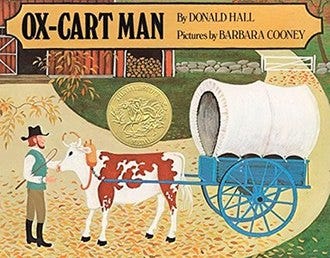I love being an editor for children’s books. But I can always notice whether an author herself reads them before she tries her hand at writing one. Children’s books should respect and love the reader as well as spark their imagination through wonder and joy as well as establish a firm foundation in reality. Books that are moralizing, sentimental, or condescending to a child’s intelligence are often red flags for me that the writer doesn’t understand how children receive stories and what draws them into a narrative.
The beauty of lyricism and poetry is one way that good writers can spark a child’s imagination. One of our family’s favorites now is Ox-Cart Man by Donald Hall and illustrated by Barbara Cooney. Donald Hall is a poet, and this story takes you on a lyrical journey through the changing season in rural New England during the nineteenth century. From the goods he packs and sells to his return home, the story reflects the beauty and simplicity of another kind of life—one that we only have to open our eyes and hearts to notice its stark differences from our own: how there often feels to be a lack in our own lives when we submit to the distractions and become attached to goods rather than people and relationships. This of course is not the “moral” of the story, but it’s often what I find myself wondering about as I read it.
Another I discovered recently is a book called Nicky & Vera: A Quiet Hero of the Holocaust and the Children He Rescued by Peter Sís. I was first drawn to this book because of something small, but significant in the title: “a quiet hero.” Isn’t this the beauty of telling stories, especially stories of such pivotal events in history? At a time when there is so much clamoring for attention, it was refreshing to know that quiet heroes still exist, and there are artists using their gifts to bring these stories to life through language, art, and beauty.
We also love Patricia Polacco’s Rechenka’s Eggs. This one is studded with subtle religious significance. Babushka’s house is adorned with beautiful iconography. In this way, the story offers a great starting point for discussions on iconography that children would be able to grasp. Whether you are three years old or thirty, you can find something meaningful and transcendent to ponder in this story.
My final favorite right now is Oscar Wilde’s The Selfish Giant, retold by Mary Hollingsworth. In the story, the selfish giant fails to share his garden with the children who enjoy it until he meets a mysterious child who leads him to a change of heart. This allegorical story is filled with Christian symbolism. Read alongside Hans Christian Andersen’s fairy tales, you notice some of the fairy-tale elements like the winter brought on by the snow queen.
I’ll leave with one more suggestion since I brought up fairy tales. This one brings tears to my eyes whenever I read it—The Little Match Girl. But I stumbled upon an interesting retelling of this classic by award-winning illustrator Jerry Pinkney. Pinkney sets Andersen’s classic fairy tale in 1920s urban America. The details in his watercolor paintings render this story so captivating and touching that anyone who reads it can’t help but be moved and transformed. The fact that he saw Andersen’s story as something so relevant to another time and place leaves you to consider why fairy tales matter not just to children but to all of us. And great stories—beautiful stories—can reveal the heart of the most important matters of our lives today.
What I’ve been up to
It’s been a busy summer, but I wrote a long-form piece in a new genre for me that will be coming soon. Stay tuned!
I’ve also enrolled in a summer seminar on Flannery O’Connor’s unfinished novel Why Do the Heathen Rage?
Finally, I signed myself up for summer camp—a short story camp where we are studying some wonderful short stories by various writers from Leo Tolstoy to Louisa May Alcott.
Thanks for subscribing to A Holy Wonder. If you’ve enjoyed the newsletter or something in it resonated with you, I invite you to share it with others.





Agree fully! Mothering and home educating our 8 children has given me lots of opportunities to read good children's books and it has truly been a gift.